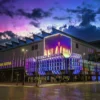Can you use sound as an experiential element? Absolutely! When considering experiential spaces, you’re really considering a methodology of engaging the senses. Sound is no exemption from this, and in fact can be a very powerful component, even on its own. Background audio can have a significant impact on an environment and those within it.
This is the reason that spas play soft instrumental tracks that often have peaceful sounds of nature intertwined, or why the same type of music is played in yoga studios. This is also the reason that loud pop music is played at bars and clubs or why classical music plays in high-end clothing boutiques. Retail stores understand the importance of the sound and music experience that keep customers happy. Corporate event audio can energize the crowd and influence emotions. The soundscape has a significant impact on our environment. You know that awful elevator music? Just think how awkward a long elevator ride would be in complete silence.
Heightening Other Senses
While audio can certainly be used on its own, the biggest use case for sound design still remains heightening the other senses. This occurs as audio cues are used to support interactions through touch, or to add depth to visuals being displayed.
Below are some great examples of how audio can play an integral role in experience design. All of these, except for the first, highlight heightening the other senses (an easier thing to show on the web). The first example is audio as an experience on its own.
C2 Montreal – Audio Controller – This video shows how event music and environment audio is easily managed with a controller.
Want to learn more about how you can utilize sound and audio cues at your next event? Drop us a line and we’ll take you through our creative sound design process!











